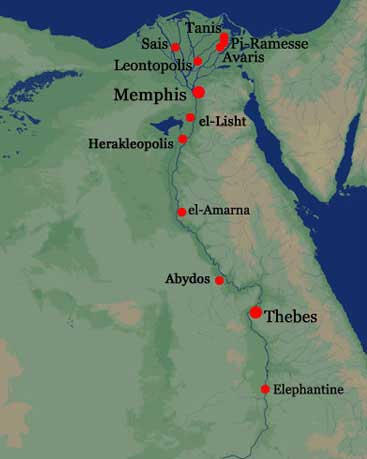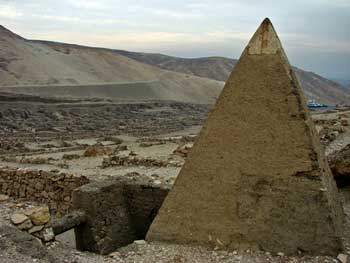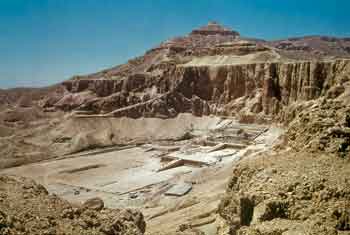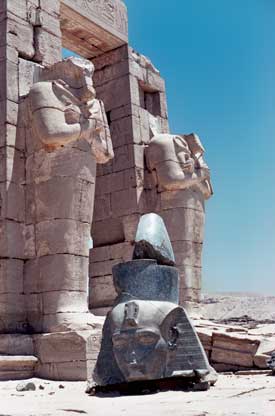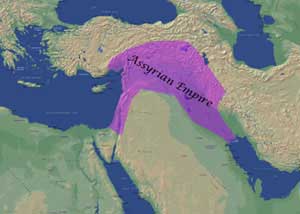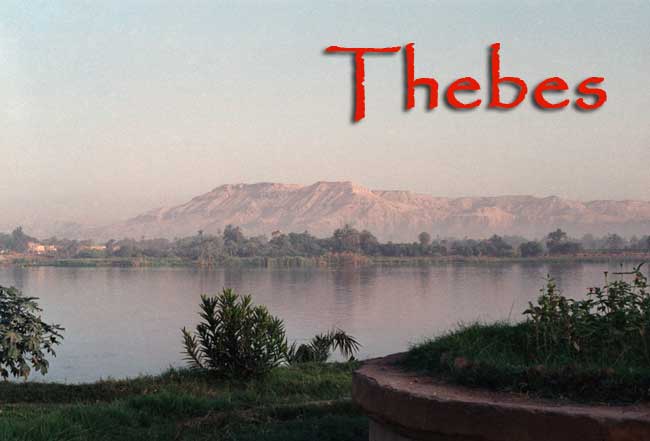
The City
The city known to Homer as ‘Thebes of the hundred gates’ was called Waset by the ancient Egyptians. The name means ‘sceptre’ and was applied to both the city and the nome of which it was the capital. The term ‘nome’ is derived from the Greek nomos and refers to the 42 provinces into which the country was divided. The Waset nome basically includes the lands on either side of river along the southern stretch of the great bend in the Nile. Its modern name is Luxor, from the Arabic al-Uqsur (‘the Palaces’).
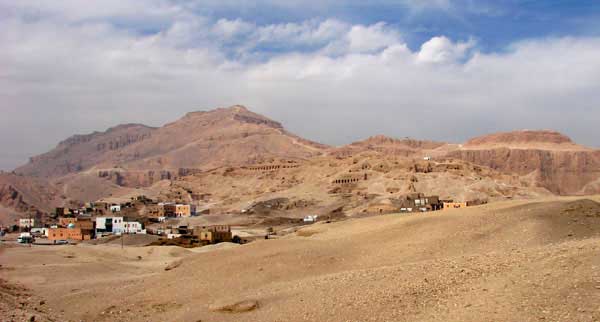
West Thebes. View of Sheikh abd el-Qurna (note the rows of private tombs in the middle distance)
Thebes was the seat of the god Amun, whose fortunes were to rise with those of the city. His main temples, the Luxor Temple and the great complex of Karnak, were both at Thebes. During the New Kingdom period, the west bank was the burial place of kings.
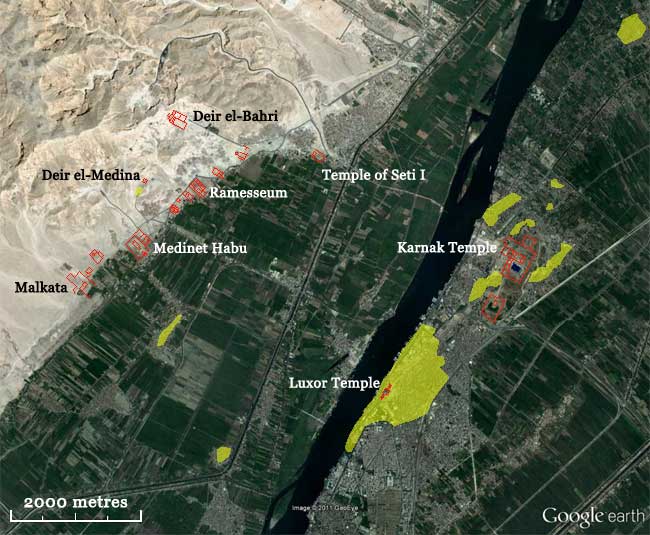
Google Earth image of Ancient Thebes with the major buildings outlined in red and the settled areas coloured yellow
No real study has been done on Egyptian settlement patterns—the lure of majestic temples and rich tombs has just been too powerful. In addition, five millennia of annual
inundations have laid 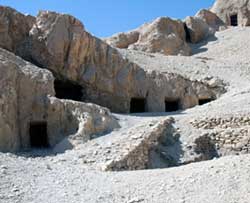 down an overburden of silt that can be several metres thick in places. Nevertheless, it is apparent that the main urban area at Thebes was on the east bank of the river, concentrated on the area around the Luxor Temple, although there was some settlement on the west bank as well—the pharaoh Amenhotep III had his palace there, at Malkata. However, for the most part the west bank was given over to the tombs and mortuary temples of the pharaohs and high officials of the Middle and New Kingdom—in common with most cultures the Egyptians believed that the west, the land of the setting sun, was the realm of the dead. Among the permanent residents of the west bank during much of the New Kingdom Period were the workers who excavated and decorated the tombs in the Valley of the Kings. They lived in a specially built village at the site of Deir el-Medina, tucked in a narrow valley on the edge of the desert.
down an overburden of silt that can be several metres thick in places. Nevertheless, it is apparent that the main urban area at Thebes was on the east bank of the river, concentrated on the area around the Luxor Temple, although there was some settlement on the west bank as well—the pharaoh Amenhotep III had his palace there, at Malkata. However, for the most part the west bank was given over to the tombs and mortuary temples of the pharaohs and high officials of the Middle and New Kingdom—in common with most cultures the Egyptians believed that the west, the land of the setting sun, was the realm of the dead. Among the permanent residents of the west bank during much of the New Kingdom Period were the workers who excavated and decorated the tombs in the Valley of the Kings. They lived in a specially built village at the site of Deir el-Medina, tucked in a narrow valley on the edge of the desert.
Predynastic (c. 10,000-3150 BC) and Early Dynastic (3150-2686 BC) Periods
The Nile Valley, including the Theban region, was not settled until the Neolithic period when the first farmers moved in from the hinterland, which was becoming increasingly arid and rapidly turning into desert. Stone artefacts, pottery and parts of buildings indicate that there was a settlement at el-Tarif on the west bank dating to the Naqada Period (c. 3700-3300 BC). The survival of material at el-Tarif is mainly due to the fact that is lies at the edge of the desert and undoubtedly there were other, probably even larger, areas of settlement that are now buried beneath the alluvium by the banks of the river. There is no evidence to suggest that Thebes was any more or less important than any of a number of similar sites in the vicinity.
The Old Kingdom (2686-2181 BC)
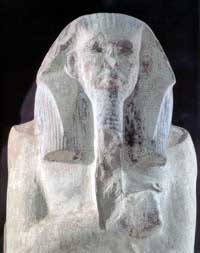 The system of administering the country by dividing it into nomes, each of which had a governor or nomarch, emerged during the Old Kingdom. The first half of this period is known as the Pyramid Age and virtually all of the surplus wealth and energy went into the glorification of the pharaohs of the Third and Fourth Dynasties. The king lived at Memphis, at the apex of the Delta, and built his tomb on the opposite bank, at one of a number of suitable locations. The largest pyramids are at Giza but there are others at Saqqara, Dashur and Meidum. His chief officials, mainly his closest relatives, were buried in mastabas or rock-cut tombs nearby.
The system of administering the country by dividing it into nomes, each of which had a governor or nomarch, emerged during the Old Kingdom. The first half of this period is known as the Pyramid Age and virtually all of the surplus wealth and energy went into the glorification of the pharaohs of the Third and Fourth Dynasties. The king lived at Memphis, at the apex of the Delta, and built his tomb on the opposite bank, at one of a number of suitable locations. The largest pyramids are at Giza but there are others at Saqqara, Dashur and Meidum. His chief officials, mainly his closest relatives, were buried in mastabas or rock-cut tombs nearby.
The ‘pyramid industry’ wound down during the Fifth and Sixth Dynasties, freeing up materials and labour for local works. All along the Nile we find the private tombs and inscriptions of hitherto anonymous officials, including five at al-Khokha (behind the Temple of Ramesses IV), which probably date to the Sixth Dynasty (2345-2181 BC). It is clear that Thebes was a rather unimportant place during this period, although there is some circumstantial evidence of royal building activity and it is possible that there was a small temple to Amun at Karnak.
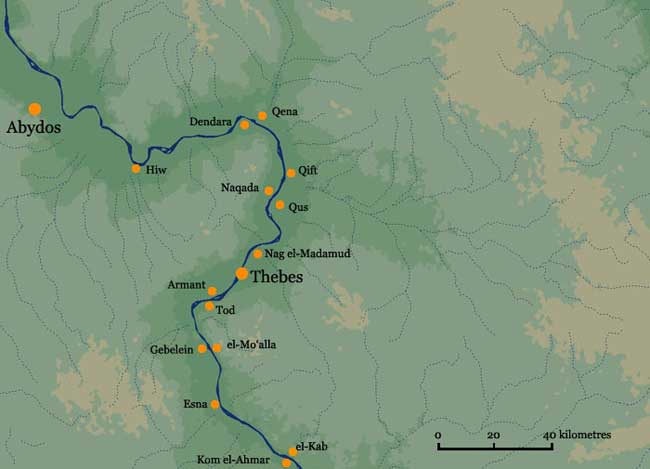
Map of Thebes & Vicinity with the ancient sites marked
The First Intermediate Period (2181-2040 BC)
Thebes first becomes important in the decades after the collapse of the central government at the end of the Old Kingdom when it becomes one of the main contenders for control of the south, Upper Egypt. There is a good deal of historical information to be found in the many inscriptions, mainly from temples and tombs, that survive from this period. Mention is made of a line of three local warlords named Inyotef, who styled themselves as pharaohs. The sad remains of their rock-cut tombs are located at Dra Abu el-Naga. The rule of the earliest pharaohs of this, the Eleventh Dynasty, did not extend north of Abydos, where the rival Tenth Dynasty rulers based at Herakleopolis held sway, but one of their descendants, Mentuhotep I, was able to reunite the country.
The Middle Kingdom (2040-1782 BC)
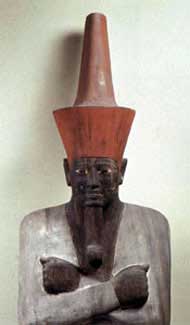 Mentuhotep, who eventually took the Horus name Smatawy (‘Uniter of the Two Lands’) was considered one of the greatest pharaohs by later Egyptians, ranking right up there with Menes as one of the founders of the country. His reign (2060-2010 BC) was a long one, fifty years, and is notable for a number of important building projects—at Abydos, el-Kab, Tod, Gebelein, Dendera, and elsewhere. The only one that has survived today is his great mortuary temple and tomb, nestled into the magnificent embayment of the cliffs at Deir el-Bahri. It is a most imposing edifice and its innovative design very much impressed later Egyptians—particularly Queen Hatshepsut who modelled her own Mortuary Temple on it (click on the link at right).
Mentuhotep, who eventually took the Horus name Smatawy (‘Uniter of the Two Lands’) was considered one of the greatest pharaohs by later Egyptians, ranking right up there with Menes as one of the founders of the country. His reign (2060-2010 BC) was a long one, fifty years, and is notable for a number of important building projects—at Abydos, el-Kab, Tod, Gebelein, Dendera, and elsewhere. The only one that has survived today is his great mortuary temple and tomb, nestled into the magnificent embayment of the cliffs at Deir el-Bahri. It is a most imposing edifice and its innovative design very much impressed later Egyptians—particularly Queen Hatshepsut who modelled her own Mortuary Temple on it (click on the link at right).
Dynasty XI ends in confusion and there is a gap in the historical record. The man who succeeded, Mentuhotep III (Nebtawyre) the last of the old line, was name Amenemhat—the same name as the vizier of the former king—and many suspect that a palace coup may have taken place. All of the evidence is circumstantial, however—perhaps the bloodline simply gave out. Amenemhat’s family were definitely not royal, but commoners from Thebes or possibly Elephantine. They were evidently devoted to Amun and three of his successors took the same name (‘Amun is foremost’). 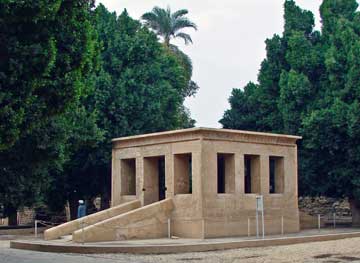 Despite this, when he took power Amenemhat decided to move the capital to a site just north of the Fayuum at el-Lisht which he named Itj-tawy, ‘Seizer of the two lands.’
Despite this, when he took power Amenemhat decided to move the capital to a site just north of the Fayuum at el-Lisht which he named Itj-tawy, ‘Seizer of the two lands.’
Thebes went into decline as all of the government workers and contractors moved away—reflected in the near total absence of tombs datable to these years—but it remained a major religious centre and the pharaohs of Dynasty XII were careful to lavish attention on Amun’s cult. As far as we know, Senwosret I (1971-1026 BC), Amenemhat’s successor, was responsible for most of the Middle Kingdom construction at Karnak, including the remains of the earliest recognizable temple and the small processional kiosk that was resurrected out of the rubble used to fill one of the later pylons (Pylon III).
The Second Intermediate Period (1782-1570 BC)
The Middle Kingdom more or less ran out of steam after the death of Amenemhat III in 1797 BC and Dynasty XII ends with the brief reign of Queen Sobeknefru (1785-1782 BC). The Thirteenth Dynasty continued to rule from el-Lisht but have left little record of their accomplishments. Maybe the fact that the sources have assigned its sixty-odd pharaohs a total of less than a century and a half suggests something of the turmoil that the country was going through during this period. Manetho assigns no fewer than 175 pharaohs belonging to five dynasties (XIII-XVII) to a period of barely two centuries. They ruled in different parts 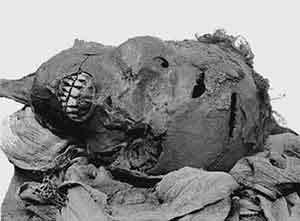 of the country and there was considerable overlap among them.
of the country and there was considerable overlap among them.
By the 16th century BC the situation had boiled down to two contending centres of power—one in the north and one in the south. The Delta was dominated by a line of foreign rulers out of western Asia, known as the Hyksos (Dynasty XV) while Upper Egypt was largely controlled by the Seventeenth Dynasty from their capital at Thebes. A showdown was inevitable and conflict broke out in the 1570s BC. Seqenenre Tao (left) died in battle against the Hyksos and his elder son, Kamose, also had a brief reign. But the country was once again united when his second son, Ahmose, finally captured Avaris and chased the Hyksos back into Palestine. The victory was a turning point in Egyptian history and marks the beginning of New Kingdom Period.
The New Kingdom (1570-1070 BC)
In light of Ahmose’s great achievement, Manetho recognizes him as the founder of a new dynasty, the Eighteenth, which was to rule Egypt for the better part of two centuries. The new pharaohs had the reputation of being great warriors and led their armies in regular campaigns up the Nile 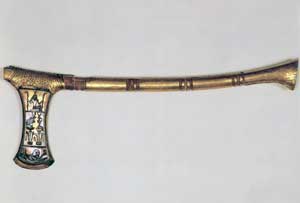 into Nubia and across the Sinai into the Levant, bringing huge amounts of tribute and booty into the state coffers—and of course the gods were owed their share. At some point during the first hundred years or so of their rule, Memphis became the political capital of the country once again but religious capital remained at Thebes, much to the benefit of the local economy.
into Nubia and across the Sinai into the Levant, bringing huge amounts of tribute and booty into the state coffers—and of course the gods were owed their share. At some point during the first hundred years or so of their rule, Memphis became the political capital of the country once again but religious capital remained at Thebes, much to the benefit of the local economy.
Ahmose (1570-1546 BC) was too busy securing his new borders to spare much thought for building activities but his son, Amenhotep I (1546-1524 BC), began to restore and expand the Karnak Temple. Unfortunately, his work there has been all but obliterated by later builders. He was apparently the first to separate his mortuary temple from the tomb but neither of these have been located. However, the fact that he was worshipped by the 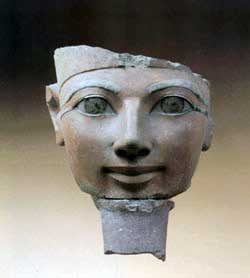 tomb workers at Deir el-Medina as the founder and patron of their community suggests he was buried in the Valley of the Kings. If so, he was the first.
tomb workers at Deir el-Medina as the founder and patron of their community suggests he was buried in the Valley of the Kings. If so, he was the first.
Things really took off under the succeeding rulers, the Tuthmosids. Tuthmosis I (1524-1518 BC) undertook a thorough remodelling and enlargement of the Karnak Temple, adding a pair of pylons and a hypostyle hall to the Middle Kingdom core. His daughter and eventual successor Hatshepsut (1498-1483 BC–left) continued her father’s work adding two pairs of obelisks along with a barque shrine known as La Chapelle Rouge. Her most enduring monument is the great mortuary temple she built next to the Temple of Mentuhotep at Deir el-Bahri.
After her death, Hatshepsut was succeeded by Tuthmosis III (1504-1450 BC), her co-ruler, nephew and stepson, who was anxious to make his mark. Where she laid the emphasis on peaceful trade, he preferred to emulate his warrior ancestors and led his armies into western Asia no less than 17 times in 20 years. The plunder was enormous and he spent in lavishly, remodelling and enlarging the work of his predecessors at Karnak. Among his many additions was a large Festival Hall, where he celebrated his jubilee.
There was another spurt of activity during the reign of Amenhotep III (1386-1349 BC) who completely rebuilt the Luxor Temple and added considerably to the one at Karnak. He also built extensively on the west bank. The remains of his palace have been excavated at Malkata but his most impressive monument was undoubtedly his mortuary temple, which was by far the largest on the west bank. The only surviving element is the pair of stone statues that originally flanked the entrance—the Colossi of Memnon.

The Colossi of Memnon
Interrupting all of this sustained building activity is what is known as the Amarna Period when the ‘heretic’ pharaoh Akhenaten proclaimed the sun-god Aten to be the one and only god and shut down the temples of all of his rival gods and goddesses. He went so far as to move his court to an entirely new capital, Akhet-aten (el-Amarna), to get away from the polluting effects of the old religion.
After the death of Akhenaten, there was a failure of the dynastic line and eventually a new dynasty, the Nineteenth, took over. The family's origins were in the north, probably in the eastern Delta—they moved their residence to , but they continued to be buried in the Valley of the Kings and lavished a good deal of wealth on the cult of Amun.
 The most prolific builder of all of them was undoubtedly Ramesses II (1279-1212 BC), whose works are found from one end of the country to the other. Ramesses dedicated his life to maintaining and expanding the borders of his kingdom. In the relief (left) he is shown subduing the Nubians on his southern border.
The most prolific builder of all of them was undoubtedly Ramesses II (1279-1212 BC), whose works are found from one end of the country to the other. Ramesses dedicated his life to maintaining and expanding the borders of his kingdom. In the relief (left) he is shown subduing the Nubians on his southern border.
At Thebes, he completed the Great Hypostyle Hall begun by his father, Seti I (1291-1279 BC) at the east end of the Karnak Temple and added a large forecourt and pylon to the Luxor Temple. He also built a mortuary temple for himself—the Ramesseum—on the edge of the cultivation on the west bank.
After Ramesses’ reign, large-scale building projects became much fewer as court intrigue and disputed successions sapped the vigour of the monarchy. The building of the Temple of Khons at Karnak by the Twentieth Dynasty pharaoh, Ramesses III (1182-1151 BC), and the construction of his mortuary temple at Medinet Habu were the last major works undertaken at Thebes before the end of the New Kingdom. His death brought about another round of intrigue, civil war and general lawlessness.
The Third Intermediate Period (1069-715 BC)
The political trends of the late New Kingdom continued into the Third Intermediate Period, another era of fragmented royal authority. While, in theory at least, the Twenty-first Dynasty ruled the whole country from Tanis in the Delta, Thebes was effectively controlled by a succession of High Priests of Amun, some of whom wrote their names in cartouches. It was these priests who removed the mummies of the New Kingdom pharaohs from their tombs in the Valley of the Kings and stashed them in tomb TT320 at Deir el-Bahri and the tomb of Amenhotep II (KV35). It is now believed that the move had more to do with ‘recycling’ the wealth of grave goods than security.
The Twenty-second Dynasty (945-715 BC) were able to reassert some sort of control over Thebes—but not without difficulty. Sheshonq I (945-924 BC) was the first pharaoh in over two hundred years to undertake any new construction at Karnak—mainly in what is now the Forecourt on the main (east-west) axis of the temple. Within a century or so, civil war broke out in Egypt and a rival dynasty, the Twenty-third (819-712 BC) rose to power at Leontopolis in the central Delta. The Thebans aligned themselves with the new rulers for the time being but in the middle of the 8th century BC a new power, Nubia, became a major player in the game. From Napata, their principal city, a succession of Nubian kings (Dynasty XXV) extended their power and influence northwards until one of them, Piankhy, took control of Thebes sometime before 740 BC.
The Late Period (716-332 BC)
Piye’s successor was his brother, Shabaka (716-702 BC) who defeated his Delta rivals fairly early in his reign and
united the whole country once again. Although they were foreigners and choose to be buried near their Nubian capital, the new rulers wholehearted adopted Egyptian ways. Their  tombs near Gebel Barkal were the first royal pyramids to be constructed in over a thousand years. Anxious to persuade native Egyptians to accept the new regime, Taharqa (690-664 BC) undertook a number of additions and restorations at the Karnak Temple. Unfortunately, his reign happened to coincide with the arrival of the Assyrians on the scene. In 671 BC, Esarhaddon invaded and captured Memphis, forcing Taharqa to flee south to Thebes. In 664 BC his son, Ashurbanipal, captured and sacked the city of Thebes—an event that rocked the ancient world. The great temples were looted and laid waste.
tombs near Gebel Barkal were the first royal pyramids to be constructed in over a thousand years. Anxious to persuade native Egyptians to accept the new regime, Taharqa (690-664 BC) undertook a number of additions and restorations at the Karnak Temple. Unfortunately, his reign happened to coincide with the arrival of the Assyrians on the scene. In 671 BC, Esarhaddon invaded and captured Memphis, forcing Taharqa to flee south to Thebes. In 664 BC his son, Ashurbanipal, captured and sacked the city of Thebes—an event that rocked the ancient world. The great temples were looted and laid waste.
After the Assyrian conquest, the Nubian kings retired to their homeland. Ashurbanipal left the Saite pharaohs of the Twenty-sixth Dynasty in charge of the Delta as Assyrian vassals. Thebes was effectively left to its own devices and was administered by its mayors with religious authority vested with the Divine Adoratrices of Amun—all of whom have left their monuments. As long as there was no trouble and the tribute was paid on time, the Assyrians were not so much concerned with local affairs.
When Ashurbanipal died in 627 BC, the Assyrian Empire went into a swift decline. Dynastic politics and widespread discontent in the provinces left it weak in the face of attacks from the outside—by the Medes and Persians in Iran, and nomadic tribesmen such as the Scythians and Cimmerians 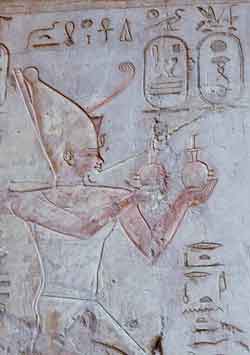 from Central Asia. Under the circumstances, distant Egypt was soon able to pretty much go its own way. The Saite rulers soon extended their authority upstream, Psamtik (664-610 BC–left) establishing his daughter, Nitocris I, as Divine Adoratrice. Nitocris served in that role until well into her 70s or even older and has left her mark at Karnak and elsewhere.
from Central Asia. Under the circumstances, distant Egypt was soon able to pretty much go its own way. The Saite rulers soon extended their authority upstream, Psamtik (664-610 BC–left) establishing his daughter, Nitocris I, as Divine Adoratrice. Nitocris served in that role until well into her 70s or even older and has left her mark at Karnak and elsewhere.
The Assyrian Empire was replaced by that of the Babylonians, the Medes and then the Persians. Using Greek and Anatolian mercenaries, the Egyptian kings were able to maintain their independence. The ambitious Necho (610-595 BC) dreamt of restoring the empire of Ramesses and Tuthmosis but his dreams were destroyed along with his army by the Babylonian Nebuchadrezzar at the Battle of Carchemesh in 605 BC. In 525 BC, the Persian king Cambyses arrived at the head of his army and defeated Psamtik III at Pelusium. The later fled to Memphis but was captured there, sent to Susa, the Persian capital, in chains and subsequently executed. Egypt was administered as a satrapy, one of two dozen into which the empire was divided. The Persian kings were listed by Manetho as the Twenty-seventh Dynasty. Native Egyptian rulers reasserted themselves at the end of the fifth century BC—Dynasties XXVIII-XXX—and there was plenty of building activity at Thebes during this period. Particularly active were Hakor (393-380 BC) of the Twenty-ninth Dynasty and Nectanebo I (380-363 BC) of the Thirtieth. The Persians returned in 342 BC to subjugate the what they still considered part of their empire. According to Greek sources, their regime was particularly brutal and the population welcomed Alexander the Great with open arms when his army arrived in 332 BC.
The Ptolemies (305-30 BC)
Alexander was acclaimed as pharaoh but did not remain for long in the country and probably never even visited Thebes—although some work was carried out in his name at Luxor and Karnak. After 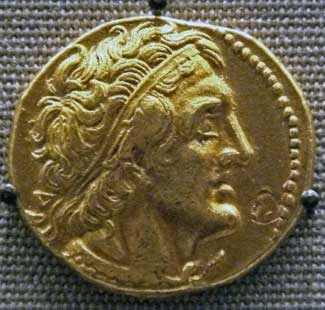 his death, Egypt, like the rest of his empire, passed first to his half-brother Philip Arrhidaeus (323-317 BC) and then to his son Alexander IV (317-305 BC). A new sanctuary to Amun was built in the name of Philip at Karnak, but that unfortunate king was hardly responsible. By the end of the fourth century BC, Alexander’s empire had been carved up by his generals with Ptolemy I (right) seizing Egypt. The Ptolemies took the new city of Alexandria as their capital and lavished their attention there.
his death, Egypt, like the rest of his empire, passed first to his half-brother Philip Arrhidaeus (323-317 BC) and then to his son Alexander IV (317-305 BC). A new sanctuary to Amun was built in the name of Philip at Karnak, but that unfortunate king was hardly responsible. By the end of the fourth century BC, Alexander’s empire had been carved up by his generals with Ptolemy I (right) seizing Egypt. The Ptolemies took the new city of Alexandria as their capital and lavished their attention there.
With the death of Cleopatra VII in 30BC, the kingdom became a province of Rome. The remains of a Roman army camp has been found at Thebes along with some murals in the Luxor Temple. By the fourth century, Christianity had become the dominant religion in the empire and in 391, by order of the emperor Theodosius, all of the pagan temples were closed and worship of the old gods was prohibited. In Egypt, as elsewhere, sites rapidly fell into decay and were quarried for their stone or covered by the drifting sands.
Suggested Reading:
| Strudwick, Nigel & Helen | 1999 | Thebes in Egypt |

